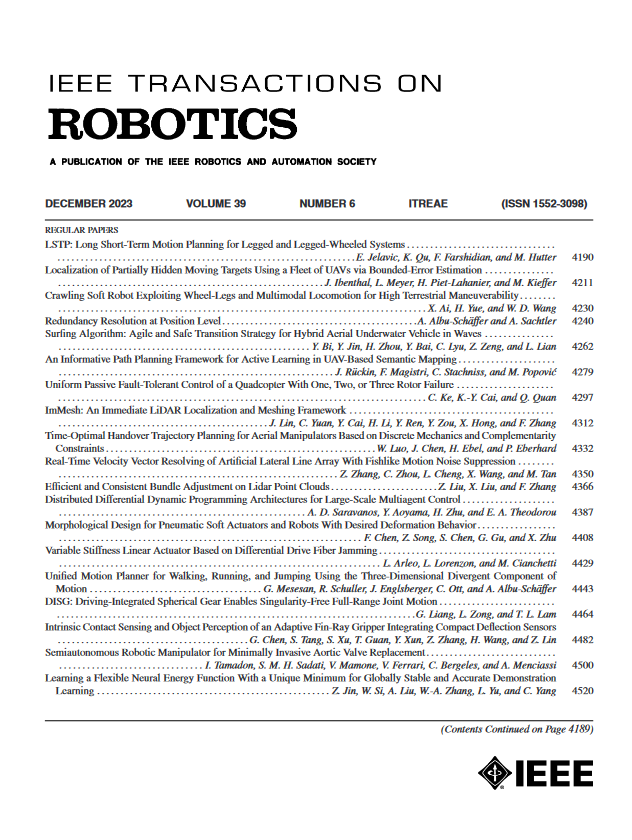Dynamic Hysteresis Compensation for Tendon-Sheath Mechanism in Flexible Surgical Robots Without Distal Perception
IF 10.5
1区 计算机科学
Q1 ROBOTICS
引用次数: 0
Abstract
The accurate position transmission of tendon-sheath mechanisms (TSMs) is challenging but of significance to the flexible robot for minimally invasive surgery. The challenges are mainly attributed to the following: first, the tendon-elongation and its caused hysteresis that depend on the route configuration of the TSM and could result in misaligned position transmission; second, realistic surgical scenarios requiring the TSM with arbitrary and even time-varying route configurations; and third the absence of distal sensory feedback due to strict spatial constraints. Existing works are always devoted to tackling the first challenge yet evade the second and third. Here, a route-related tendon-elongation model is formulated to resolve the first challenge, and in response to the second, a route-sensing optical fiber is used. Obeying the third challenge, a feedforward hysteresis compensator is then developed to align the distal position of the tendon with the desired position. Our final contribution gives an application-oriented remedy for the foregoing methodologies. Applying our compensator on the challenging position transmission tasks subject to second and third challenges, the positional accuracy can be still maintained at around 97.50%; guided by the provided remedy, the surgical end-effector achieves submillimeter tip position accuracy. Extensive tests demonstrate that the pending concerns yet of great practical importance in existing related works are well resolved.无远端感知柔性手术机器人肌腱鞘机构的动态滞后补偿
肌腱鞘机构(TSMs)的准确位置传递是柔性机器人进行微创手术的一个挑战,但也具有重要意义。挑战主要在于:首先,肌腱伸长及其引起的迟滞依赖于TSM的路径配置,可能导致位置传递错位;第二,现实的手术场景要求TSM具有任意甚至时变的路由配置;第三,由于严格的空间限制,远端感觉反馈的缺失。现有的作品总是致力于解决第一个挑战,而回避第二个和第三个挑战。在这里,制定了与路线相关的肌腱伸长模型来解决第一个挑战,并针对第二个挑战,使用了路线传感光纤。服从第三个挑战,然后开发一个前馈滞后补偿器,将肌腱的远端位置与期望位置对齐。我们最后的贡献为上述方法提供了一种面向应用程序的补救方法。将该补偿器应用于受第二、第三挑战的挑战性位置传输任务,位置精度仍能保持在97.50%左右;在提供的补救措施的指导下,手术末端执行器达到亚毫米尖端位置精度。大量的试验表明,在现有的相关工作中尚未解决但又具有重要实际意义的问题得到了很好的解决。
本文章由计算机程序翻译,如有差异,请以英文原文为准。
求助全文
约1分钟内获得全文
求助全文
来源期刊

IEEE Transactions on Robotics
工程技术-机器人学
CiteScore
14.90
自引率
5.10%
发文量
259
审稿时长
6.0 months
期刊介绍:
The IEEE Transactions on Robotics (T-RO) is dedicated to publishing fundamental papers covering all facets of robotics, drawing on interdisciplinary approaches from computer science, control systems, electrical engineering, mathematics, mechanical engineering, and beyond. From industrial applications to service and personal assistants, surgical operations to space, underwater, and remote exploration, robots and intelligent machines play pivotal roles across various domains, including entertainment, safety, search and rescue, military applications, agriculture, and intelligent vehicles.
Special emphasis is placed on intelligent machines and systems designed for unstructured environments, where a significant portion of the environment remains unknown and beyond direct sensing or control.
 求助内容:
求助内容: 应助结果提醒方式:
应助结果提醒方式:


